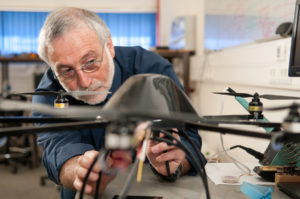
Autonomous Vehicles for Sea, Air and Land
Autonomous Vehicles for Sea, Air and Land
September 11, 2017
Homeland & Cyber Security, Robotics & High-Tech
Ynet News — Aided by engineers at Ben-Gurion University of the Negev, a number of state-of-the-art unmanned military vehicles will be rolled into the service of the Israel Defense Forces (IDF) within the next few years, according to a recent announcement by the Administration for the Development of Weapons (ADW) in Israel’s Ministry of Defense.
Autonomous Sub
In the navy, as opposed to the air force, the selection of unmanned naval instruments is scarce and relatively limited. The small “unmanned undersea vehicle” (UUV) is expected to change that. Other versions of this unmanned submarine already exist in the world, but now an Israeli version is being developed thanks to research by Prof. Hugo Guterman, director of BGU’s Laboratory for Autonomous Robotics and member of the BGU Homeland Security Institute.
The UUV is a miniscule sub used for scanning and mapping missions that may be launched from either the shore, a manned submarine or a ship. The UUV will then be able to dive in a rapid, almost vertical line, moving in any direction it needs. It will cost – according to the Ministry of Defense – a third of its international counterparts.
Watch a video of the BGU-developed autonomous sub>>
While work on the UUV is ongoing, a larger version is being developed. “Little Caesar” (Keysaron in Hebrew) is a true submarine for all intents and purposes, except for the fact that it’s unmanned. This large version will be used for covert operations such as information gathering.
Copter Drone
BGU is also helping to develop top-grade “unmanned aerial vehicles” (UAV). One drone in particular is an autonomous mini-copter. Developed in collaboration with a subsidiary of Aeronautics Defense Systems (ADS) in Beer-Sheva, the prototype is considered a breakthrough in the still-burgeoning field of UAVs.
This mini-copter drone, far removed from the models the IDF has already been employing for near-range observation missions, has a diameter of two meters (6.5 feet) and weighs 120 kilos (almost 265 pounds) when fully loaded – 75 to 90 kilos (165 to 200 pounds) of which may be the cargo attached to it.
“We’ll want to reach weights of 200 and 300 kilos in the future [441 to 661 pounds],” said a source in ADS, which specializes in manufacturing UAVs and observation balloons for the IDF and other security apparatuses in the world.
“The drone we developed can fly at exceedingly low altitudes in a manner that both masks it to the naked eye and is energy efficient,” the spokesman said.
This innovative drone can carry a variety of cargo for special forces, such as a team of soldiers carrying out a covert observation while lying in ambush. The cargo may include observation devices, batteries, weapons, ammunition, or food and water.
One of the aerial vehicle’s most distinguishing features is its hybrid engine that integrates electric propulsion from batteries with the use of petrol. This enables the drone to reach distances beyond eight kilometers (five miles). It may also be programmed to be controlled from afar.
When compared to a garden-variety UAV, however, one of the drone’s drawbacks is its short air-time capability; it’s also noisy, which could expose it to enemy forces. “It’s for this reason we’re working on propellers made of special materials producing less noise,” an ADS spokesman explained.
It’s doubtful whether these drones will phase out UAVs completely, but the security establishment is ecstatic with the fact the drone may lift off the ground from any point on the terrain vertically – similar to a helicopter – without requiring runways.
Other new armaments showcased in the Ministry of Defense report, but not yet operational, included a manned and unmanned version of a speedy smart armored tank with the ability to go undetected; a drone sniper that shoots small arms fire from the air; a smart rifle that discharges only after locking onto a target; the “Sky Eye” drone that autonomously scans and documents a six-mile area; autonomous infantry robots and vehicles; and more.
For more on unmanned submarines and vehicles, read the full story on the Ynet News website>>
For more on unmanned drones, read the full story on the Ynet News website>>






